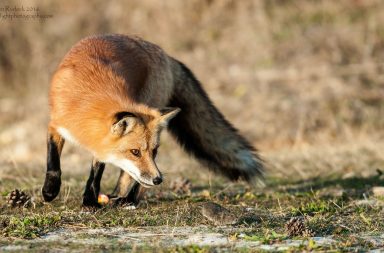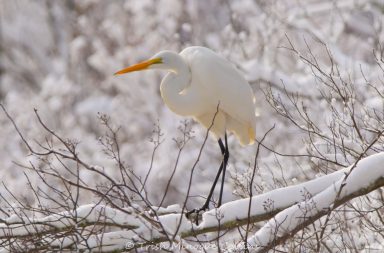HORNED GREBE
The Horned Grebe gets its name from the golden-yellow patches of feathers behind its eyes, which looks like short horns. The size of this bird, 12-15 inches, is not in proportion to the big interest its life generates among birders. The Grebe begins life breaking out of a bluish white egg with a beige stain in a nest that has been built of floating vegetation. This nest is attached to underwater plants somewhere in a fresh-water lake or marsh in Alaska & Northern Canada. The baby Grebe may have 4 to 7 siblings and can swim as soon as it breaks out of the egg; however, it will frequently ride on the back of its’ parents. It also eats the feathers of its parents – presumably to line its stomach so the bones of the prey that it consumes will not pass into the intestines. Grebes continue to do this in adulthood as well.
The parents are quite handsome in their breeding plumage. A slender, chestnut colored neck & flank, a dark back with golden feathers, looking like “horns”, above and behind the eyes and a bill that is short and straight. Since they are a diving bird, their feet are placed well back on the body (making it difficult to walk out of water) and the birds are seldom seen on land.
Horned Grebes have an interesting courtship display which is called “rushing”. This is where both birds rise out of the water and glide, side by side, across the surface. They will also exchange gifts of weeds, accompanied by a lot of head shaking. The calls of the Horned Grebe include a long, squealing trill which descends in pitch and ends in a rattle.
After the young are grown they, and the adults, migrate to salt water where they spend the winter. Their winter plumage is a white chin and neck and dark upper parts. They eat mainly aquatic insects, mollusks, and crustaceans.
The oldest recorded Horned Grebe was at least 5 years, 11 months old. Folk names of this bird include Devil-diver, hell-diver, pink-eyed diver, and water witch.
An interesting tidbit of folk-lore: “In Blackfeet lore, the trickster Old Man tricked several ducks into closing their eyes and dancing while he killed them one by one. The smallest duck looked and alerted the others. This “duck” was the Horned Grebe, who became the first to notice trouble.” (from What Bird . com)
Horned Grebes are a migratory species, breeding in southern Alaska, western and central Canada, and into the northern United States (as well as across Europe & Asia). Here in the US they winter along coastal waters in the east as well as California and Texas. Horned grebes can be seen in L.I. waters all winter. We usually only see them in their winter plumage but sometimes, if one is lucky, in late February or early March a bird going into breeding plumage can be spotted.

Ed Walsh

Ed Walsh

Ed Walsh

Ed Walsh

Ed Walsh
More images on pages 2,3 and 4



